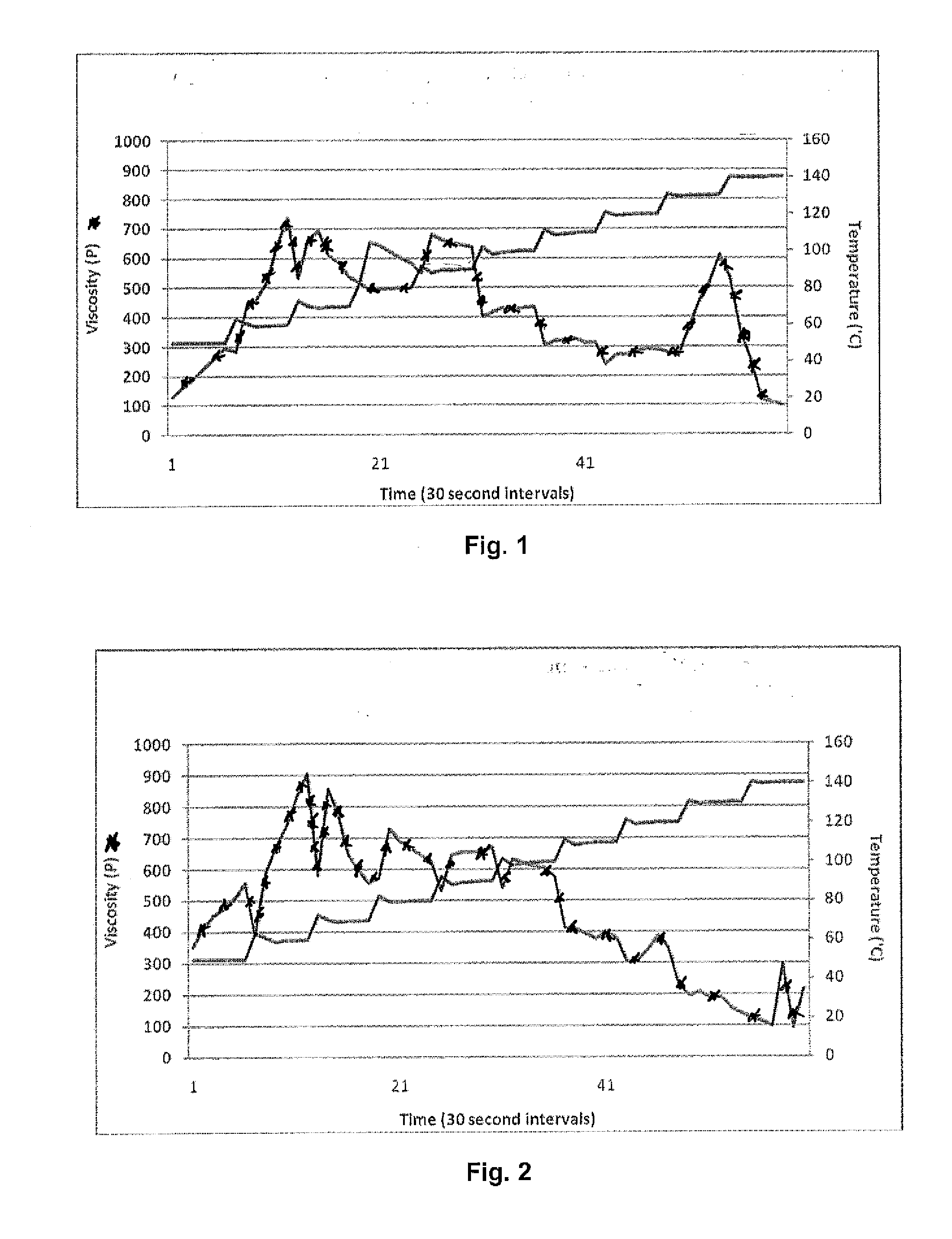Melt-Blended Protein Composition
a protein and composition technology, applied in the field of meltblended protein composition, can solve the problems of limiting the type of components that may be used in the composition, solvent-based solutions require a substantial amount of time, energy and material processing, and the ability to use a “solventless” process is complicated
- Summary
- Abstract
- Description
- Claims
- Application Information
AI Technical Summary
Problems solved by technology
Method used
Image
Examples
example 1
[0068]A mixture of 40 wt. % vital wheat protein and 60 wt. % glycerol was initially formed and tested for viscosity at various temperatures. More particularly, viscosity was taken on a cone and plate Brookfield CAP 2000+H Viscometer (25 rpms). Viscosity was measured as temperature step increases were implemented and shear rate was held constant. The results are shown in FIG. 1. As illustrated, the optimal temperatures occurred between 50° C. to 70° C., when the protein was taken in the plasticizer through interstices while maintaining a quaternary protein structure. When 90° C. was reached, viscosity began to behave classically in that as temperature increased, viscosity decreased. When the temperature reached 130° C., there was a large spike in viscosity followed by a drop off. It is believed that this is a result of protein aggregation (polypeptide network formation from disassociated polypeptides).
example 2
[0069]A mixture of 36.9 wt % vital wheat protein, 55.3 wt. % glycerol, and 7.8 wt. % glycidyl hexadecyl ether (“GHE”) was initially formed and tested for viscosity at various temperatures as described in Example 1. The resulting viscosity profile is shown in FIG. 2. As illustrated, the optimal swelling temperature was 50° C. to 70° C.; however, there was no aggregation peak at 130° C. It is believed that the absence of an aggregation peak indicated that the addition of GHE was absorbed by the vital wheat gluten during the 50° C.-70° C. temperatures. When dissociation of the polypeptide was initiated at elevated temperatures, the sulfhydryl groups reacted with GHE rather than creating crosslinks, thus preventing polypeptide network formation.
example 3
[0070]A “PRISM USALAB 16” lab scale twin screw extruder was employed to melt process a sample of 70 wt. % protein (WhetPro® 75), 24 wt. % glycerol, 5 wt. % GHE, and 1 wt. % DECONOX™ MTS-90. The extruder contained eleven (11) different zones, although zones 1 through 5 were not utilized in this Example. Temperature zone 11 was a strand die. The temperature profile of zones 6 to 11 was 32° C., 38° C., 44° C., 55° C., 70° C., and 70° C., respectively. The protein was added to the extruder at zone 6 at a feed rate of 0.5 lbs / hr. A pre-blended mixture of 80 wt. % glycerol, 18 wt. % GHE, and 2 wt. % MTS-90 was then added at zone 7 at a feed rate of 0.211b / hr. The mixture was added on a hot plate to melt the GHE. The screw configuration was composed of conveying elements at zones 6 and 7, kneading blocks at zones 8 and 9, and conveying elements at zone 10. The screw speed was 50 rpm.
[0071]The material was successfully extruded, producing a smooth homogeneous, pelletizable strand. The proce...
PUM
| Property | Measurement | Unit |
|---|---|---|
| temperature | aaaaa | aaaaa |
| wt. % | aaaaa | aaaaa |
| temperature | aaaaa | aaaaa |
Abstract
Description
Claims
Application Information
 Login to View More
Login to View More - R&D
- Intellectual Property
- Life Sciences
- Materials
- Tech Scout
- Unparalleled Data Quality
- Higher Quality Content
- 60% Fewer Hallucinations
Browse by: Latest US Patents, China's latest patents, Technical Efficacy Thesaurus, Application Domain, Technology Topic, Popular Technical Reports.
© 2025 PatSnap. All rights reserved.Legal|Privacy policy|Modern Slavery Act Transparency Statement|Sitemap|About US| Contact US: help@patsnap.com

